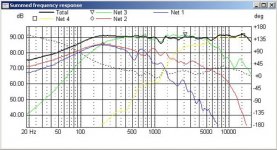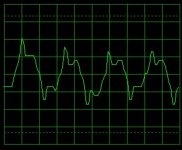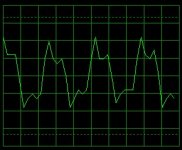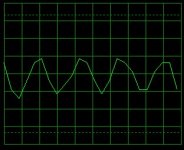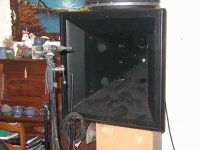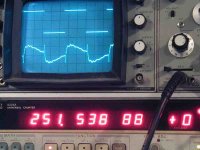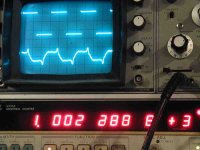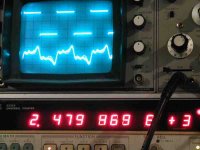Hi all
I am trying to find screen shots or measured data etc of loudspeakers producing a square wave.
This is turning out to be harder to find than I first thought.
I have seen many references to it, know first hand a Manger driver can, the Dunlavy’s are suppose to but when you read the website, they are talking about electrical summation and not measured response with the drivers included.
Can anyone point me towards results of two or three way speakers doing it in real life, that is a mic signal not a simulation.
Preserving time (and so waveshape) well enough to do this has been an interest for a long time and I am interested to see where I am relative to hifi speakers.
Thanks much
Tom Danley
Danley Sound Labs
I am trying to find screen shots or measured data etc of loudspeakers producing a square wave.
This is turning out to be harder to find than I first thought.
I have seen many references to it, know first hand a Manger driver can, the Dunlavy’s are suppose to but when you read the website, they are talking about electrical summation and not measured response with the drivers included.
Can anyone point me towards results of two or three way speakers doing it in real life, that is a mic signal not a simulation.
Preserving time (and so waveshape) well enough to do this has been an interest for a long time and I am interested to see where I am relative to hifi speakers.
Thanks much
Tom Danley
Danley Sound Labs
Hi Tom,
Good to see you again, last time was 5 or 10 years ago by e-mail.
B&O was very big on this when they were promoting their filler driver, "the missing link" innovation. There was a large white paper from the company and an AES paper. The paper is in the AES "Loudspeaker anthology" Vol. 1 - Vol. 25 (1953-1977) with the title "A Novel Approach to Linear Phase Loudspeakers Using Passive Crossover Networks" Erik Baekgaard
There are oscilloscope traces in there, they're square more or less, much better than most speakers but nothing like an amplifier.
I was impressed with the innovative thinking in this project, but it's rather complex for what you get in the end.
Are you looking for anything in particular?
Here's one on the web:

From:
http://www.silcom.com/~aludwig/Final_system_measurements.htm#Transient_and_square_wave_response
I find this analysis interesting but I'm not in the linear phase camp based on what I know and like based on listening tests. I'll take linear phase, of course, if it can be had without compromising other characteristics but I've not seen an implementation with few compromises.
Pete B.
Good to see you again, last time was 5 or 10 years ago by e-mail.
B&O was very big on this when they were promoting their filler driver, "the missing link" innovation. There was a large white paper from the company and an AES paper. The paper is in the AES "Loudspeaker anthology" Vol. 1 - Vol. 25 (1953-1977) with the title "A Novel Approach to Linear Phase Loudspeakers Using Passive Crossover Networks" Erik Baekgaard
There are oscilloscope traces in there, they're square more or less, much better than most speakers but nothing like an amplifier.
I was impressed with the innovative thinking in this project, but it's rather complex for what you get in the end.
Are you looking for anything in particular?
Here's one on the web:

From:
http://www.silcom.com/~aludwig/Final_system_measurements.htm#Transient_and_square_wave_response
I find this analysis interesting but I'm not in the linear phase camp based on what I know and like based on listening tests. I'll take linear phase, of course, if it can be had without compromising other characteristics but I've not seen an implementation with few compromises.
Pete B.
This is something I've been meaning to test for some time on my linear phase speakers, Delta, but I don't have an oscilloscope or open space to carry it out.
Still I thought for fun I'd try it using Speaker Workshop to generate the square waves & some Oscilloscope freeware and perform the tests in my listening room. The results are not too bad (see next post), although the measuring resolution is a bit course.
Below is the LspCAD predicted frequency response & phase of Delta.
Still I thought for fun I'd try it using Speaker Workshop to generate the square waves & some Oscilloscope freeware and perform the tests in my listening room. The results are not too bad (see next post), although the measuring resolution is a bit course.
Below is the LspCAD predicted frequency response & phase of Delta.
Attachments
Hi
Thanks for the replies guys, this is the most data I have found so far.
PB2, to answer your question about what I’m looking for, I designed a speaker for work that while it isn’t made for, or is small enough for the home, it does have the best imaging and sound I’ve ever heard in my living room. I’m trying to get a handle on what hifi speakers do time wise, how many can preserve waveshape and over what bandwidth.
I know there aren’t any pro sound speakers that do
The “goal” on all the full range speakers I’ve been working on is to make a multiway speaker that radiates as if it were a single source in time and space with controlled directivity down to a frequency set by the horns physical size.
I said the H word, yes, the speaker is a horn, part of what it has to do is be about 20dB or more louder than home speakers. The cool part here though is as loud as I would ever have it, they are still loafing.
The idea in this, called a Synergy horn (an extension of the Unity horn) was to use one horn body and drive is along its length, according to the expansion rate which is sort of a high pass filter for horn loading.
The physical position of each frequency range is offset by the phase shift in the crossover network and (when everything is right) you have what looks like a single source and the horn is loaded over a vastly larger range than it could be with only one real driver.
I listening to them last night and thought, “you know I should see what a square wave looks like”.
Anyway I set up and then took some pictures and that prompted my search.
I measured starting at 210Hz, where it starts to look like a square and then every 1/3rd octave above up to 3.15KHz where it poops out and looks like a triangle.
Picture 1 is the speaker, a dusty SH-50 in my living room, mic is an earthworks at about 3 feet although it looks closer from this angle.
Picture 2 is at 250Hz
Picture 3 is at 1KHz
Picture 4 is 2.5Khz
When the weather gets better, I am going to haul one up on the tower and see what square waves look like without all the room reflections.
Anyway, its not a home speaker but maybe you guys will get a kick out of it.
Best,
Tom Danley
Thanks for the replies guys, this is the most data I have found so far.
PB2, to answer your question about what I’m looking for, I designed a speaker for work that while it isn’t made for, or is small enough for the home, it does have the best imaging and sound I’ve ever heard in my living room. I’m trying to get a handle on what hifi speakers do time wise, how many can preserve waveshape and over what bandwidth.
I know there aren’t any pro sound speakers that do
The “goal” on all the full range speakers I’ve been working on is to make a multiway speaker that radiates as if it were a single source in time and space with controlled directivity down to a frequency set by the horns physical size.
I said the H word, yes, the speaker is a horn, part of what it has to do is be about 20dB or more louder than home speakers. The cool part here though is as loud as I would ever have it, they are still loafing.
The idea in this, called a Synergy horn (an extension of the Unity horn) was to use one horn body and drive is along its length, according to the expansion rate which is sort of a high pass filter for horn loading.
The physical position of each frequency range is offset by the phase shift in the crossover network and (when everything is right) you have what looks like a single source and the horn is loaded over a vastly larger range than it could be with only one real driver.
I listening to them last night and thought, “you know I should see what a square wave looks like”.
Anyway I set up and then took some pictures and that prompted my search.
I measured starting at 210Hz, where it starts to look like a square and then every 1/3rd octave above up to 3.15KHz where it poops out and looks like a triangle.
Picture 1 is the speaker, a dusty SH-50 in my living room, mic is an earthworks at about 3 feet although it looks closer from this angle.
Picture 2 is at 250Hz
Picture 3 is at 1KHz
Picture 4 is 2.5Khz
When the weather gets better, I am going to haul one up on the tower and see what square waves look like without all the room reflections.
Anyway, its not a home speaker but maybe you guys will get a kick out of it.
Best,
Tom Danley
Attachments
That's a good result Tom, though that spike on the tailing edge is a little curious.
This is indeed a good result.
But the peak may very well be the LEADING edge. I.e. it might be the tweeter that is out of phase to the rest (AKA 2nd order LR).
Regards
Charles
Square wave measurements on Jordan TL. Distance 1 meter, 15 degrees off axis.
1000 Hz
100 Hz
1000 Hz
An externally hosted image should be here but it was not working when we last tested it.
100 Hz
An externally hosted image should be here but it was not working when we last tested it.
- Home
- Loudspeakers
- Multi-Way
- Making Square Waves?
